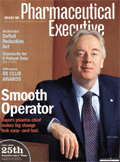Opinion: AARPeeved
Pharmaceutical Executive
Critics of the pharma industry have gotten good at selective reporting. So good, I've started tuning out. But, with a public official pulling similar punches, my ears can't help but perk up.
Anybody else had enough of the AARP's regular "Trends" reports on prescription-drug pricing? I'd been tuning them out, since the only difference from one report to the next was the date. But Rep. Henry Waxman (D-CA), with his September 2006 analysis on industry profits since the implementation of Part D, has reignited my interest—and my ire.

Peter J. Pitts
Let's start with AARP.
The first thing to note is that "Trends" relies on a measure of wholesale cost from a proprietary dataset—not the actual prices paid by cash customers. Patients with insurance (yes, like Part D) don't ever see these prices. America's insured focus their attention and anger on ever-rising co-pays (which increase many-times-fold the price of the prescription medicines they are, in theory, linked to).
I think the folks over at Big Insurance (yes, like the AARP) have some explaining to do.
The AARP report also regularly ignores the impact of patent expiration and generic-drug entry on the overall cost of therapy. It's intellectually dishonest to only focus on a "basket" of on-patent medications while ignoring the cost savings that occur when patents expire. This is particularly important since 50-percent-plus of all scripts are filled with generics!
In other words, the typical cash-paying senior will experience less than half of the increase the AARP report claims. And why aren't these people on Part D, anyway? Or is this report only a veiled marketing tool to get more seniors to sign up for the AARP plan? Just wondering.
And in the spirit of transparency (and we all agree that transparency is a good thing, right?) consider this: The AARP report is produced by Stephen Schondelmeyer, a well-known critic of Big Pharma and an advocate for the generic-drug industry. And, speaking of transparency, why doesn't AARP use the dataset available from CMS—a very carefully developed, publicly available measure of price trends actually faced by consumers? Just wondering.
Now, as to Mr. Waxman, a few comments:
His analysis, written in response to AARP's "reporting" on the subject, claims that since the implementation of Part D, the net income of Pfizer (our planet's largest pharmaceutical company) grew from $3.7 billion in the first half of 2005 to $6.5 billion in the first half of 2006. A $2.8 billion gain. Wow, right?
Not so much when you consider that Pfizer's second-quarter SEC filing showed that growth was driven by increased interest earnings of $1.5 billion and $1.1 billion worth of favorable tax provisions. That adds up to $2.6 billion of the $2.8 billion gain. Not so "wow" after all.
This stuff isn't secret, it's public—and if I can find it then Mr. Waxman is hiring the wrong interns.
(I should also add that, according to Fortune, the pharmaceutical industry is ranked 34th among all industries by growth and 31st in return to shareholders.)
But wait, there's more ...
Mr. Waxman's report claims that the pharmaceutical industry has reaped a $2 billion windfall from reduced rebates because of the shift of Medicaid dual-eligibles to Medicare Part D.
Nope. CMS estimates that 2006 Medicare drug plan discounts and rebates will average 27 percent rather than the 15 percent initially projected. And you know where that rebate money comes from, right?
But the most absurd claim from Henry "Big Soundbite" Waxman is that Big Pharma's ability and willingness to raise prices is a direct result of Part D and the non-interference clause.
Nope. Consider the facts:
- According to CMS, the average 2007 Medicare-drug-plan premium will be $24, 40 percent lower than the original projection
- Competitive bids submitted to CMS are, on average, 10 percent lower than they were in 2006
- The 2006 Medicare Trustees Report projects 20-percent-lower Part D spending over the coming decade than did the 2005 report.
It must really gall Mr. Waxman that competition (like in private-marketplace competition) really does drive price down and quality up.
Me? I actually read Wealth of Nations in my high school AP World History class.
Peter J. Pitts is a former associate commissioner for FDA. He can be reached at ppitts@cmpi.org

Beyond the Prescription: Pharma's Role in Digital Health Conversations
April 1st 2025Join us for an insightful conversation with Jennifer Harakal, Head of Regulatory Affairs at Canopy Life Sciences, as we unpack the evolving intersection of social media and healthcare decisions. Discover how pharmaceutical companies can navigate regulatory challenges while meaningfully engaging with consumers in digital spaces. Jennifer shares expert strategies for responsible marketing, working with influencers, and creating educational content that bridges the gap between patients and healthcare providers. A must-listen for pharma marketers looking to build trust and compliance in today's social media landscape.